TUFLOW 1D Flood Modeller Connectivity: Difference between revisions
Tuflowduncan (talk | contribs) No edit summary |
Tuflowduncan (talk | contribs) |
||
| Line 30: | Line 30: | ||
It is not possible to have a HX connection to ESTRY and a X1DQ connection at the same node. This is because the X1DQ connection node is snapped to the Flood Modeller node and the model thinks it's trying to connect a HX and X1DQ to the same Flood Modeller node. In this situation it would be necessary to insert a small dummy channel between the X1DQ node and the node connected to the HX boundary. |
It is not possible to have a HX connection to ESTRY and a X1DQ connection at the same node. This is because the X1DQ connection node is snapped to the Flood Modeller node and the model thinks it's trying to connect a HX and X1DQ to the same Flood Modeller node. In this situation it would be necessary to insert a small dummy channel between the X1DQ node and the node connected to the HX boundary. |
||
An example model containing both X1DH and X1DQ connection is available from [ |
An example model containing both X1DH and X1DQ connection is available from the [https://gitlab.com/tuflow-user-group/third-party-tools/other/flood-modeller-tuflow-linked-examples TUFLOW User Group Gitlab Page]. This is available as 2 models, one with direct snapping between nodes and the ESTRY channel and other which uses X-connectors. |
||
==Checking whether a X1DH or X1DQ Setup has been Successful== |
==Checking whether a X1DH or X1DQ Setup has been Successful== |
||
Revision as of 01:57, 5 September 2024
Introduction
TUFLOW models can be configured with Flood Modeller to allow dynamically linked models comprising 1D pipe networks, represented in ESTRY (aka TUFLOW 1D), open channels represented in Flood Modeller Pro and/or ESTRY and the 2D representation of surface flow represented in TUFLOW 2D. This allows full integrated catchment modelling. There are two types of linking:-
- A "X1DH" link where a Flood Modeller 1D water level is being applied at the ESTRY node (i.e. Flood Modeller sends ESTRY a water level and ESTRY sends back a discharge to Flood Modeller).
- A "X1DQ" link where a Flood Modeller inflow/outflow is being applied at the ESTRY node (i.e. Flood Modeller sends ESTRY a discharge and ESTRY sends back a water level).
An ESTRY X1DH (the default) would be used for most Flood Modeller ESTRY links where TUFLOW is discharging into Flood Modeller. The discharge will be applied to the Flood Modeller 1D model as a lateral inflow. The Flood Modeller 1D node on the receiving end of an X1DH connection must be a channel unit (eg, River, Interpolate, Replicate or Conduit) and must not be the end node of a reach (ie, distance to next cross section of zero). This is commonly used when representing a pipe network within ESTRY which discharges to an open channel represented in Flood Modeller as per Figure 1.
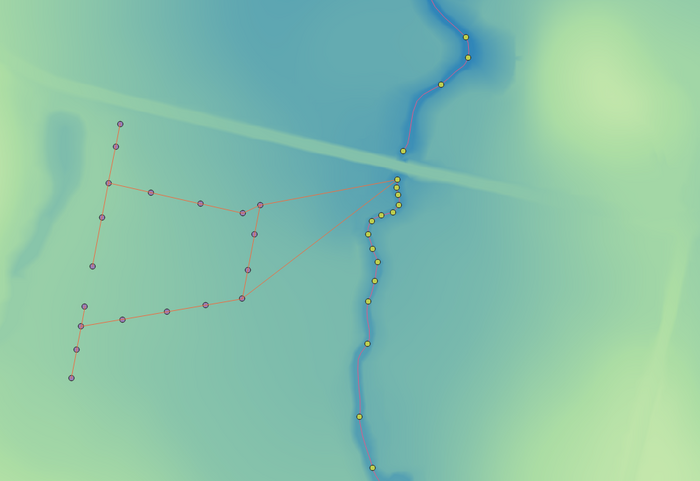
An X1DQ might be more appropriate where a Flood Modeller model stops and flows into an ESTRY model. The water level calculated by TUFLOW is applied as a time-varying head boundary in Flood Modeller. The Flood Modeller 1D node on the end of an X1DQ connection must be an HTBDY unit. This does not need to contain any boundary data as this data will be overridden by the water levels provided by TUFLOW.
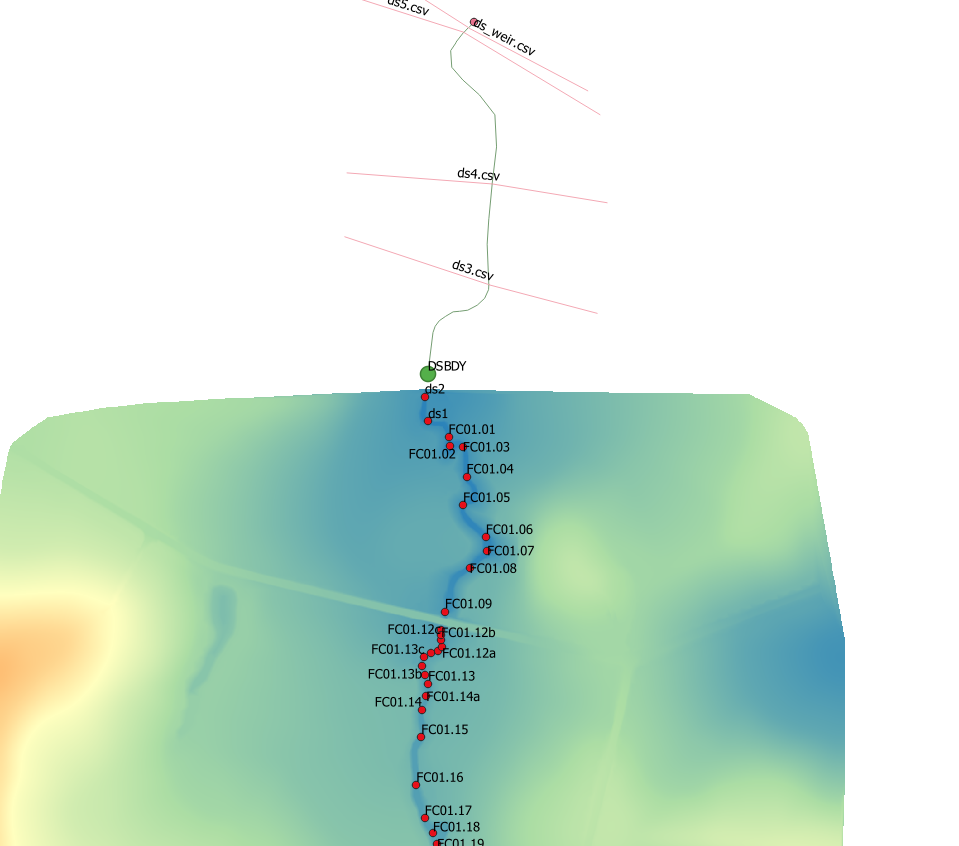
NOTE: Remember that the Flood Modeller node ID is Case Sensitive.
Building an ESTRY-Flood Modeller 1D-1D Connection
Flood Modeller and TUFLOW will be considered linked if an ESTRY node in a 1D_nwk layer and a Flood Modeller node in a Read GIS ISIS Nodes or Read GIS ISIS Network layer are snapped together (see Figure 3). Ensure that the 2 nodes are snapped, or that a snap tolerance is being used. The ESTRY node should have a 1d_nwk Conn_1D_2D attribute of either "X1DH" or "X1DQ". If Conn_1D_2D field is blank then “X1DH” is assumed (see Figure 4). Note that the upstream and downstream inverts for the ESTRY node linked to Flood Modeller should be set to -99999 unless the node is also being used to set the inverts of channels snapped to it.
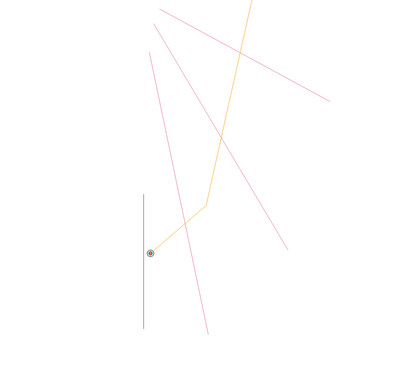
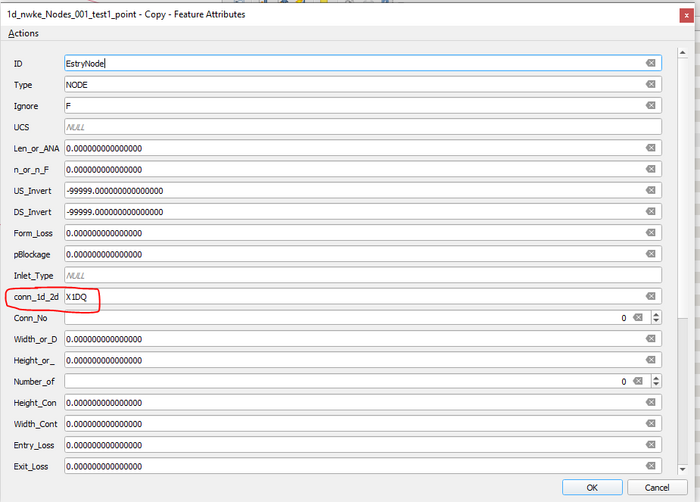
A connector "X" channel type can be used to connect the end of the linked ESTRY channel to the ESTRY node snapped to the Flood Modeller node if the end of the ESTRY channel and the snapped Flood Modeller /ESTRY nodes are not in the same location. In this case it is important that the X-connector is drawn from the ESTRY channel (ie, the first vertex on the polyline) to the ESTRY node which is snapped to the Flood Modeller node (see Figure 5). The Flood Modeller node label in the 1d_x1d_isis layer should match that within the Flood Modeller network.
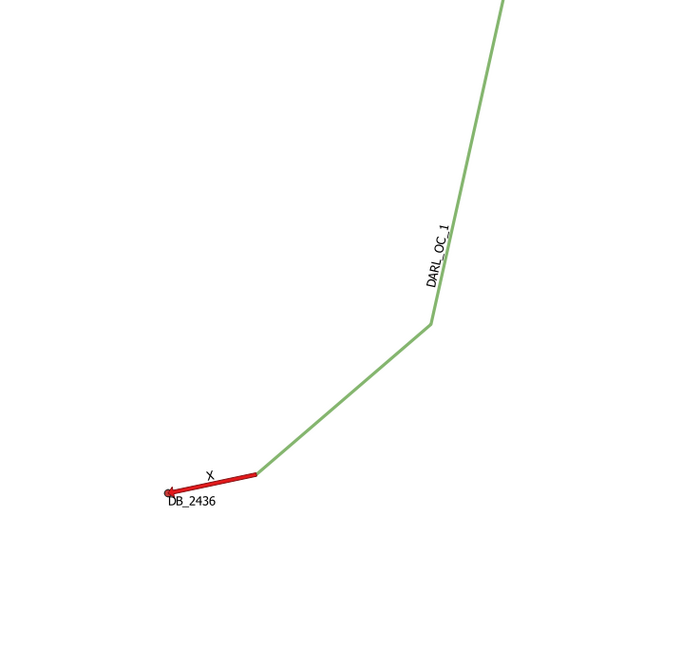
It is not possible to have a HX connection to ESTRY and a X1DQ connection at the same node. This is because the X1DQ connection node is snapped to the Flood Modeller node and the model thinks it's trying to connect a HX and X1DQ to the same Flood Modeller node. In this situation it would be necessary to insert a small dummy channel between the X1DQ node and the node connected to the HX boundary.
An example model containing both X1DH and X1DQ connection is available from the TUFLOW User Group Gitlab Page. This is available as 2 models, one with direct snapping between nodes and the ESTRY channel and other which uses X-connectors.
Checking whether a X1DH or X1DQ Setup has been Successful
The first location to look for confirmation that a X1DQ or X1DH connection has been picked up is to look into the simulation tlf file. This will list the number of X1DQ and X1DH connections to the Flood Modeller network.

The type or existence of a connection can be also be checked by viewing the Conn_1D_2D attribute in the 1d_nwk_N_ check layer as shown in Figure 7.
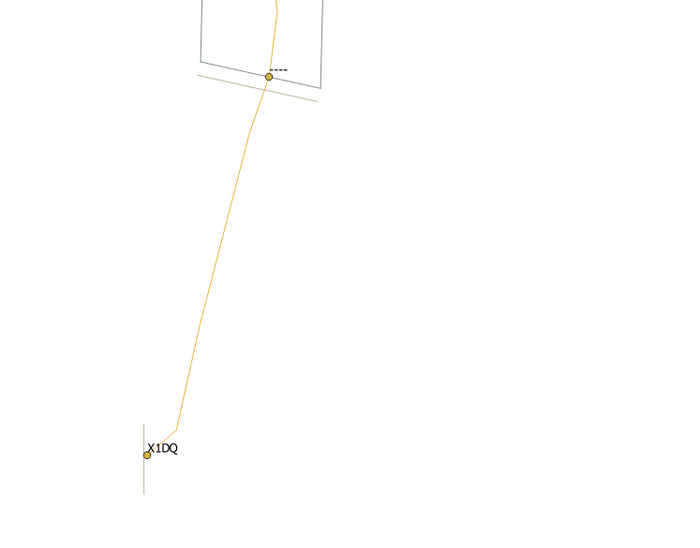
The _messages.mif/.shp layer contains CHECK 1393 messages at each ESTRY node linked to a Flood Modeller node. The presence of this message indicates that the TUFLOW 1D (ESTRY) node has been successfully connected to a Flood Modeller node and therefore no action is required.
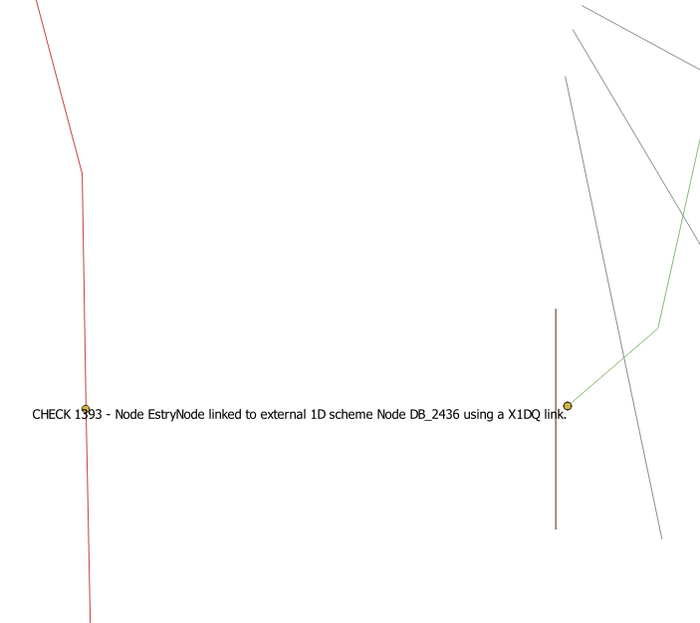
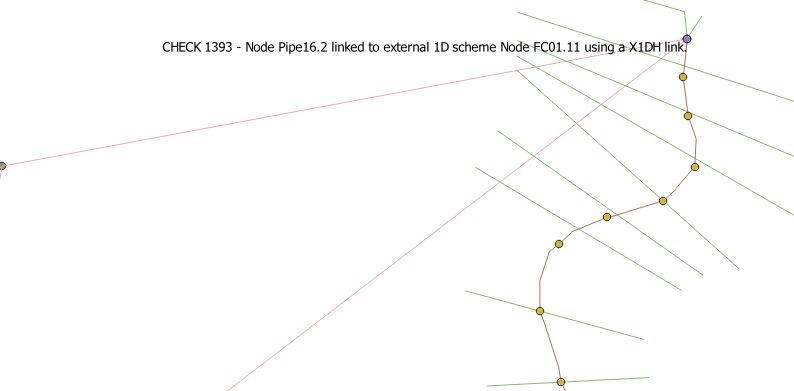
Interrogating Results for an ESTRY-Flood Modeller 1D Link
Generally, an ESTRY timestep will be smaller than the Flood Modeller timestep. In these cases, the total volume is accumulated over all ESTRY timesteps within a Flood Modeller timestep, and applied to the Flood Modeller model as a discharge by dividing the volume by the Flood Modeller timestep. The mass balance _MB1D.csv file includes four new columns:
- X1DH V In: The volume of water in via a X1DH link.
- X1DH V Out: The volume of water out via a X1DH link.
- X1DQ V In: The volume of water in via a X1DQ link.
- X1DQ V Out: The volume of water out via a X1DQ link.
These additional outputs are shown in the highlighted columns in the image below. In this example there is an example of an 'X1DH' link and an 'X1DQ' link.
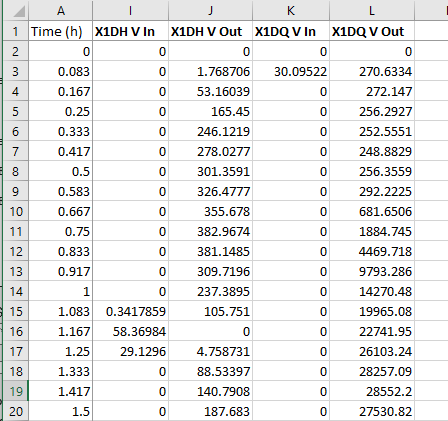
Results can also be plotted using the TUFLOW Viewer. In the case of a X1DH link between ESTRY and FLOOD Modeller, results are shown in Figure 10.
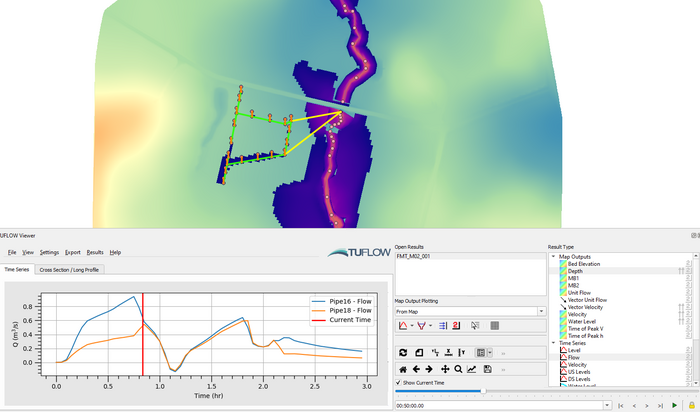
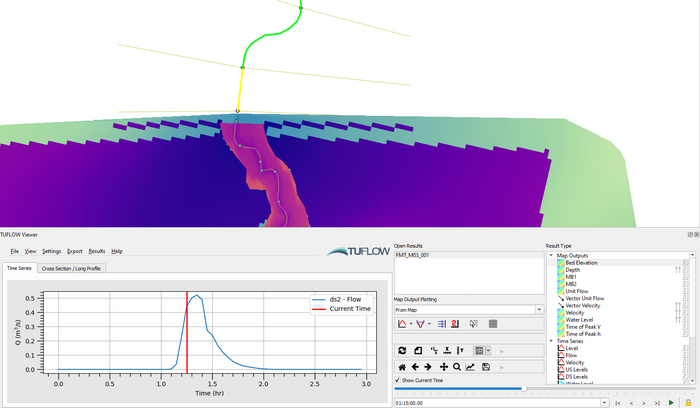
Summary
Flood Modeller and ESTRY (TUFLOW 1D) models can be dynamically coupled to enable a bi-directional connection between the two software using either a X1DH link or a X1DQ link. The linkage take place when an ESTRY node and Flood Modeller node are snapped together. Where an ESTRY channel is also attached flow is transferred at this interface. When an ESTRY channel is not connecting, an X-connector is required to connect the snapped ESTRY/Flood Modeller node to the ESTRY channel. The dynamic coupling allows full integrated catchment modelling with open channels being represented in Flood Modeller, Pipe networks being modelled in ESTRY and the urban surface and floodplain being modelled in TUFLOW 2D. From Flood Modeller 4.5, there is also the capability to run linked Flood Modeller-ESTRY models with TUFLOW HPC. This allows models to be run on multiple processors and on GPU cards for significant speed gains for the integrated catchment model. Further details can be found in the following page.